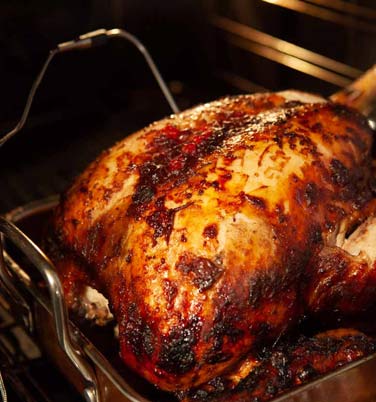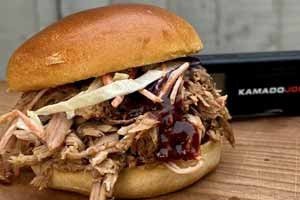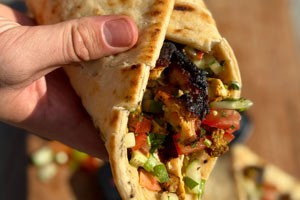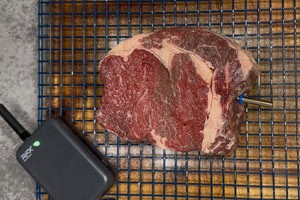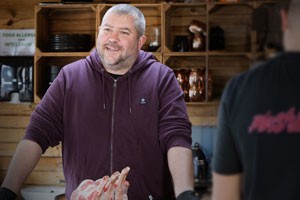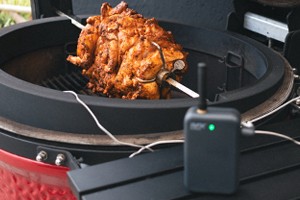Easy, tender BBQ pulled pork, loaded into buns with coleslaw and BBQ sauce.
The Ultimate Turkey Cooking Guide
Cooking a turkey can send fear rippling through the hearts of even the best home cooks. Will it defrost in time? Do I brine it? What even is brining? Is it cooked? Why is it dry? How do I rest it? Can I reheat it? We've all asked ourselves these questions.
Here we'll look at how to cook a turkey, from defrosting to reheating. We'll also examine the common questions, dilemmas and pitfalls cooks experience along the way. Read on to find out how to prepare and rest turkey, the cooked temperature of turkey, and which meat thermometers are best for turkey.
How to defrost a turkey
First things first, frozen turkeys need to be safely and thoroughly defrosted.
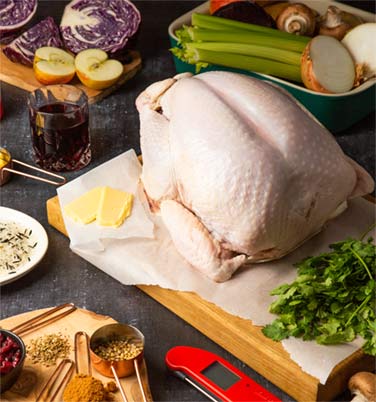
Turkey should only ever be defrosted in the fridge, never at room temperature. The reason for this is that the outside of the meat will get too warm and enter the danger zone (the temperature range where harmful bacteria thrives), while the middle will still be frozen. Defrosting turkey in the refrigerator allows all of the meat to rise to a safe cold temperature.
How long to defrost your turkey depends on its size. Your packet instructions should guide you, but the general rule is that a turkey needs 24 hours per every 2kg of meat.
To ensure that your turkey is thoroughly defrosted all the way through, you can probe the centre of the meat with a meat thermometer like the Thermapen. It should be around 5 °C once defrosted, the same temperature as your fridge. Make sure to thoroughly disinfect the probe after to prevent cross-contamination.
How to prepare a turkey
Brining vs basting
Traditional turkey recipes often suggest basting the meat as it cooks. However, it is now understood that brining is more likely to increase the juiciness of the meat whilst also creating a crispy skin. This is because soaking or covering lean meats, like turkey, in salt loosens the proteins for a more tender texture. Basting juices tend to run over the meat rather than penetrating it.
What is brining?
Brining is essentially marinating your meat in a salt solution. It can be either wet or dry, and you can add additional flavours, like herbs and spices, if you like.
Wet brining involves combining salt and cold water and soaking your turkey in the solution prior to cooking. It takes less time than dry brining, usually 12-24 hours. However, it takes up more space, as you need a solid container to fill with the liquid and place the turkey inside.
Dry brining means rubbing your turkey skin with salt (and other dry flavours, if desired). This should be done further in advance, 24-48 hours before cooking. The turkey can be kept inside a bag or smaller container so it takes up less space.
Removing from the fridge
Another misconception is allowing the turkey to come to room temperature before cooking. It's not necessary to do this.
It's better for the turkey to be uniform in temperature to ensure even cooking — removing it from the fridge early will only make the outside warmer while the inside remains cold.
What temperature is turkey cooked?
The most important tip when cooking a turkey is to cook it to temperature, not time. Turkey meat can easily become overcooked and dry, and this way you can be confident it's safe to eat whilst ensuring it's still nice and juicy.
All turkey meat should reach an internal temperature of 74 °C to be safe to consume. This includes whole turkeys, turkey crowns and turkey breast.
Carryover cooking
When you remove any meat from the heat, the temperature will continue to rise for a while after. This is called carryover cooking. The bigger the meat, the more the temperature will rise.
You can take your turkey out of the oven slightly below 74 °C, and it will still rise to a safe temperature as it rests. We’d recommend removing a whole turkey from the oven at 67 °C, making sure to monitor the temperature during the rest to check that it reached a safe temperature of 74 °C.
How to check if turkey is cooked
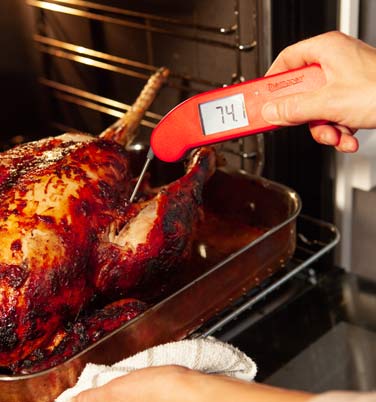
To take the temperature of your turkey, insert your Thermapen probe into the thickest part of the meat. For whole turkeys, this is usually between the breast and the thigh, but take the temperature in a few places just to be sure. Be careful to avoid bones and gristle as these will give an inaccurate reading.
How to rest a turkey
Resting your turkey before carving is important to allow the juices to redistribute for maximum juiciness throughout. It also makes it more flavourful and easier to carve.
Resting times:
How long you should rest it for depends on the size, as a general rule:
Small turkey (3.6-5.4kg): Rest for about 20-30 minutes.
Medium turkey (5.4-7.3kg): Rest for about 30-45 minutes.
Large turkey (7.3-9.1 kg): Rest for about 45 minutes to 1 hour.
Very Large Turkey (9.1+ kg): Rest for at least 1 hour, or up to 1.5 hours.
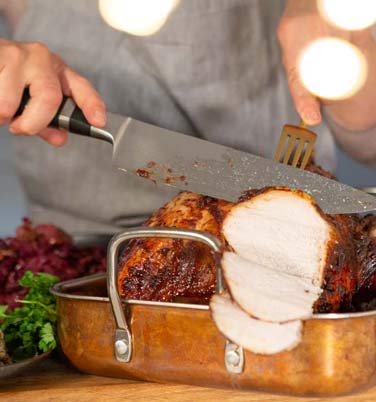
To cover or not to cover?
Loosely covering your turkey with aluminium foil during the rest will help retain the meat retain moisture. However, don't cover it tightly or it can make the skin soggy. If you're aiming for crispy skin, the best option is to rest it uncovered.
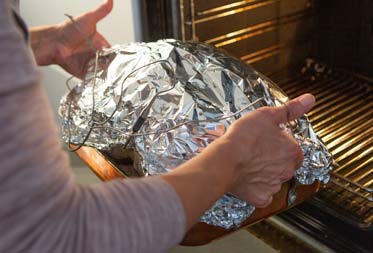
How to reheat a turkey
Before reheating turkey, it's also really important to cool it safely. After cooking, the meat should be placed in the fridge within two hours to prevent the spread of harmful bacteria. Make sure the meat isn't still hot when you put it in the fridge, though, as this will increase your fridge temperature and put your other chilled foods at risk.
You can reheat turkey in the microwave, oven, BBQ, or any way you like, as long as it reaches 74 °C. However, because turkey is a lean meat it's susceptible to drying out. To keep it juicy, place in an oven tray and pour over stock and some knobs of butter. Cover with foil and heat on 180 °C fan until it reaches 74 °C.
BEST TURKEY THERMOMETERS
Learn more about the different types of meat thermometers for turkey.
Best essential turkey thermometer
If there's one thermometer you need for your turkey, it's a Thermapen Classic. With fast and accurate readings and a robust splashproof casing, it's everything you need in a trusty kitchen thermometer. Handmade in Britain and loved by home cooks and professional chefs worldwide, you can count on the Classic to ensure your turkey is cooked perfectly.
Best premium turkey thermometer
A step-up from the Classic, the Thermapen ONE is the ultimate meat thermometer for turkey. With lightning-fast one-second readings and waterproof casing, it's ready for any cooking challenge. Additional features like the 360° auto-rotating screen, backlit display and auto on/off functions make it super easy to use. The Thermapen ONE is the ultimate sidekick for turkey and all the trimmings.
Best leave-in meat thermometer for turkey
Instant-read thermometers are essential for probing your turkey all over to confirm it's done. But to make it even easier, you can also add a leave-in meat thermometer to your cook to notify you as soon as it reaches temperature.
The DOT digital oven thermometer is the perfect tool for this. Use the up/down arrows to set your desired temperature, insert the probe into the turkey and place the meat into the oven. The DOT is magnetic so you can attach it to your oven or BBQ, or you can stand it on your counter. You can watch the temperature climb, and once the turkey reaches your desired temperature the alarm will sound.
Best thermometer for turkey storage
When your fridge is packed with turkey and trimmings, the last thing you want is for your fridge temperature to be off. Your fridge should be around 5 °C, and maintaining this temperature will help to keep your food fresher and maximise its shelf life. Our Digital Fridge Thermometer makes it easy to check your fridge is at optimum temperature any time you open it, and the safety zone indicator will help you to know if it’s risen to an unsafe level. Perfect for keeping all your festive goods stored safely.
The takeaway
The most important tip for ensuring your turkey is juicy is to use a thermometer to cook it perfectly to 74 °C. An instant-read meat probe is essential for this, while a leave-in meat thermometer will make it even easier to take your turkey out of the oven at the optimum time.
For food safety, make sure to defrost your turkey thoroughly in the fridge before cooking.
Depending on the size of your turkey, resting the meat for between 20 minutes and 1 hour 30 minutes will help it to become even juicier and more delicious. Covering loosely with foil will add extra moisture, while resting uncovered will ensure a crispy skin.
Store cooled cooked turkey in the fridge within two hours of cooking, and reheat to 74 °C.
Adding some stock and butter to the reheating process will prevent dry leftovers.
